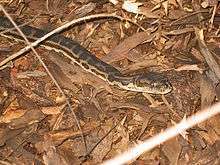Morelia spilota imbricata
| Morelia spilota imbricata | |
|---|---|
 | |
| Scientific classification | |
| Kingdom: | Animalia |
| Phylum: | Chordata |
| Subphylum: | Vertebrata |
| Class: | Reptilia |
| Order: | Squamata |
| Suborder: | Serpentes |
| Family: | Pythonidae |
| Genus: | Morelia |
| Species: | M. spilota |
| Subspecies: | M. spilota imbricata |
| Trinomial name | |
| Morelia spilota imbricata (L.A. Smith, 1981) | |
| Synonyms | |
| |
Morelia spilota imbricata is a large snake found in southern regions of Western Australia and western South Australia. A member of the python family, it is commonly known as the southern carpet python.[2]
Taxonomy
A member of the Pythonidae, M. s. imbricata is closely related to other Australian diamond or carpet pythons (genus Morelia), and is placed as a subspecies of Morelia spilota. The abundant and well known genus Morelia contains five species across Australia, but it is only this subspecies that occurs in the west.[3]
Description
It has a total length up to 2.3 m (7.5 ft), 2.0 m (6.6 ft) from snout to vent (SVL). This species has a well defined neck and small scales across the head. Males may be up to 1.1 kg (2.4 lb) in weight, females may be four times heavier when fully grown. Larger individuals have been given as 4 m (13 ft) in total length.[4]
Several other similar pythons occur in its range. The woma, Aspidites ramsayi, lacks the obvious neck of M. spilota imbricata, and the western Stimson's python, Antaresia stimsoni stimsoni, has a higher number of ventral scales.
Habitat
The habitat is coastal areas, woodland, heathland, and semiarid areas. It is often found in woodlands of Eucalypt and Banksia, or amongst grasses or low growing shrubs.
Behavior
It is discrete and slow moving, spending most of its time hidden, though occasionally it is seen attempting to cross roads. Typically this python is sedentary, but females in a survey at Garden Island were noted to be active most of the year. M. spilota imbricata takes up residence in deep crevices or holes in limestone, on granite, in dense heath, and animal burrows.
Diet
This subspecies eats geckos, house mice, birds, and marsupials, including the Tammar wallaby.[4]
Home range
Individuals may have a large range, occupying hollow logs in cooler months and wandering across areas up to 20 ha (49 acres). Males tend to have a larger range. They appear to return to the same sites, even after long absences, which may contribute to a threat of extinction.[5]
Conservation
Morelia spilota imbricata is widespread and thought to have large populations, but is exposed to the threatening processes of its distribution range.[5] Noted in the assessment of its conservation status are land clearing and altered fire regimes, as it typically occupyies a large undisturbed habitat. The impact of introduced predators, known to be foxes and cats, have not been assessed. Population densities have declined in the Esperance region. The various threat assessments have described it as near threatened (Red list 2000) and 'specially protected fauna' under its region's Wildlife Conservation Act.[4] The hollow logs favored by the species are not produced by altered fire regimes or cleared in plantations.[5]
Geographic range
It occupies all the regions of Southwest Australia, a typical mediterranean climate, and into the central arid and semiarid regions. The northern extent is to Geraldton and it is found as far east as the Eyre Peninsula. The python also occurs on islands at the Houtman Abrolhos, Garden Island, and the Archipelago of the Recherche. There are records of the subspecies beyond the eastern mainland range from St Francis Island in South Australia's Nuyts Archipelago.[3]
See also
- List of pythonid species and subspecies
- Pythonidae by common name
- Pythonidae by taxonomic synonyms
References
- ↑ The Reptile Database. www.reptile-database.org.
- ↑ "Morelia spilota imbricata". Integrated Taxonomic Information System. Retrieved 20 March 2008.
- 1 2 Browne-Cooper, Robert; Brian Bush; Brad Maryan; David Robinson (2007). Reptiles and Frogs in the Bush: Southwestern Australia. University of Western Australia Press. p. 99. ISBN 978-1-920694-74-6.
- 1 2 3 "Carpet Python Morelia spilota (Lacépède, 1804)". NatureBase.
- 1 2 3 Pearson, D.; Shine, R.; Williams, A. (May 2005). "Spatial ecology of a threatened python (Morelia spilota imbricata) and the effects of anthropogenic habitat change". Austral Ecology. 30 (3): 261–274(14). doi:10.1111/j.1442-9993.2005.01462.x.
Further reading
- Smith, L.A. 1981. A Revision of the Python Genera Aspidites and Python (Serpentes: Boidae) in Western Australia. Rec. West. Australian Mus. 9 (2): 211-226. ("Python spilotus imbricatus subsp. nov.", pp. 222–224, Figure 7.)
External links
| Wikimedia Commons has media related to Morelia spilota imbricata. |
- Morelia spilota at the Reptarium.cz Reptile Database. Accessed 15 February 2008.